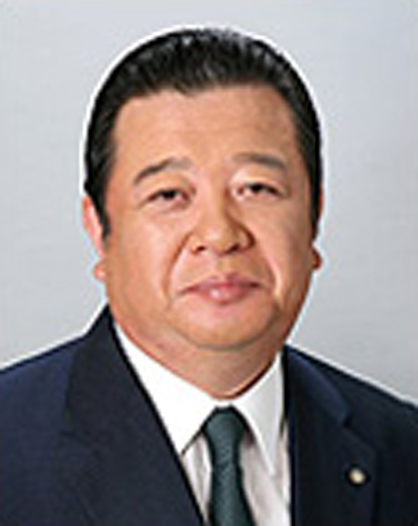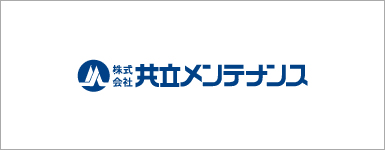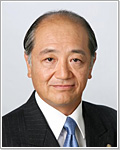| Kyoritsu Maintenance Co., Ltd. (9616) |
|
||||||||||||||
Company |
Kyoritsu Maintenance Co., Ltd. |
||
Code No. |
9616 |
||
Exchange |
TSE 1st Section |
||
Chairman |
Haruhisa Ishizuka |
||
President |
Mitsutaka Sato |
||
HQ Address |
Soto Kanda 2-18-8, Chiyoda-ku, Tokyo |
||
Year-end |
March |
||
URL |
|||
* Share price as of closing on November 29, 2013. Number of shares outstanding as of most recent quarter end excluding treasury shares.
ROE is based on actual results of the previous term end. |
||||||||||||||||||||||||
|
|
* Estimates are those of the Company.
This Bridge Report provides information about Kyoritsu Maintenance Co., Ltd. including a review of first half earnings fiscal year March 2014 earnings.
|
| Key Points |
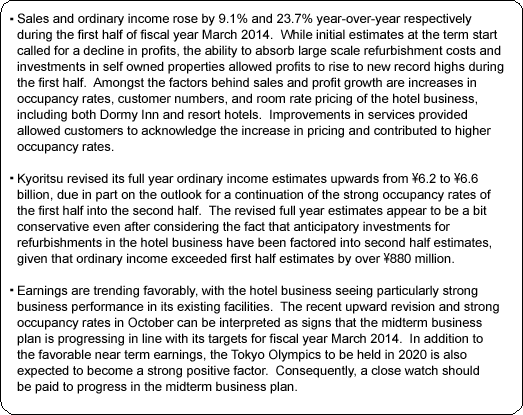 |
| Company Overview |
|
Sales by business segment for fiscal year March 2013 are provided below. 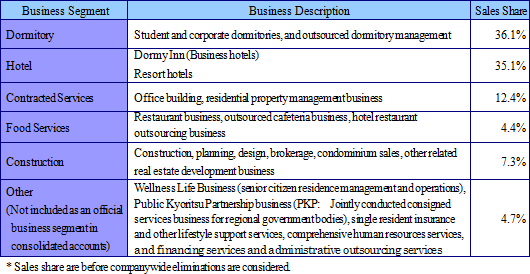 <Corporate History>
Kyoritsu Maintenance was established in September 1979. The founder, Haruhisa Ishizuka, had long been associated with the food service industry and started the Company by taking on the operations of corporate cafeteria facilities on a consigned basis. In the following year of 1980 in Sakura City, Chiba Prefecture, the Company established a two story wooden structure with 28 small four Japanese straw mat rooms as its first dormitory facility. Based on the principle of providing "food" that "fosters the health and well being of students to put their parents' minds at ease," Kyoritsu was able to steadily expand its student dormitory business through partnerships with various schools. The Company steadily expanded its operating territory to cover the Tokyo, Kanagawa, Nagoya and Osaka regions. In April 1985, Kyoritsu began offering corporate dormitories to employees that offered highly unique features of "individual rooms with commissary functions providing breakfast and dinner," and "large bathing facilities" as comforting amenities for residents. In May 1987, Kyoritsu began eating-out business based on know-how for board, which was cultivated through consignment business for dormitories and facilities for boarding. In June 1993, the Company moved its headquarters to its current location and in July of the same year it entered the resort hotel business with the opening of a facility in Nagano Prefecture, followed by their entry to the business hotel realm in August with the opening of a facility in Saitama Prefecture. In September 1994, Kyoritsu listed its shares on the JASDAQ Market (At the time called the OTC Market), in March 1999 it moved its listing to the Second Section of the Tokyo Stock Exchange, and then to the First Section in September 2001.
|
| Midterm Business Plan: "Kyoritsu Value Up Plan!" (FY3/12 to FY3/16) |
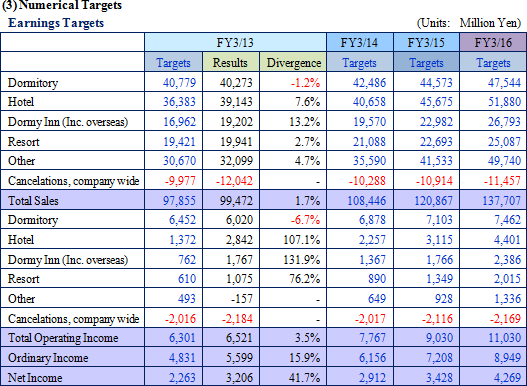  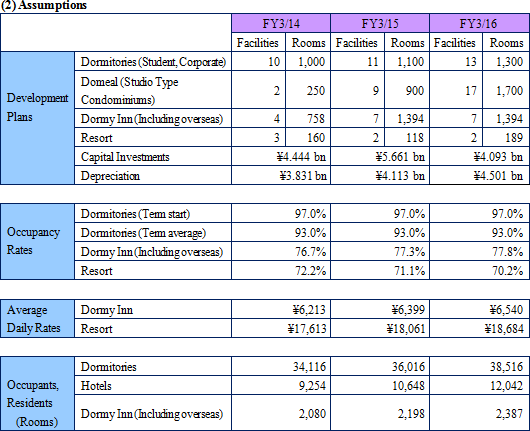 |
| First Half Fiscal Year March 2014 Earnings Results |
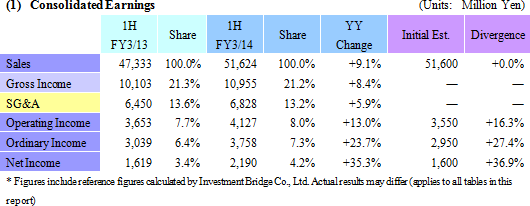 Sales, Ordinary Income Rise 9.1%, 23.7%
Sales rose by 9.1% year-over-year to ¥51.624 billion during the first half. Increases in the number of residents due to new facility openings and in occupancy rates of 0.5% year-over-year at the start of the term contributed to a rise in sales of the dormitory business. At the same time, the hotel business also saw higher sales on the back of new facility openings and improvements in occupancy rates and pricing. Increases in development projects contributed to an increase in sales of the construction business. Furthermore, other business segments also saw increases in its sales. With regards to profits, the hotel business saw strong performance and surpassed the dormitory business by achieving ¥2.694 billion in operating income and boosting total operating income to ¥4.127 billion. Declines in interest payments and foreign exchange translation gains allowed ordinary income to rise by an even larger margin of 23.7% year-over-year to ¥3.758 billion.Initial estimates at the start of the current term called for declines in profits of the dormitory business due to large scale refurbishments and development costs of self-owned facilities. However, the hotel business has become a driver of growth and allowed Kyoritsu to achieve record high operating, ordinary and net incomes during the first half. The midterm dividend is expected to be raised from ¥19 in the previous first half to ¥21 per share at the end of the current first half.  Dormitory Business
Occupancy rates got off to a good start at the start of fiscal year March 2014 and rose by 0.5% compared with the previous fiscal year to 97.0%, with the number of contracted residents at the end of the first half rising by 1,003 from the end of the previous first half to 30,484. However, an increase in the number of new residents moving into dormitories early in March contributed to a decline in contract fees received. Consequently sales growth was restrained to 2.4% year-over-year to ¥20.477 billion. The increase in resident contracts contributed to an increase in marginal profitability of ¥514 million. However, the early entry of residents in March and cancellations of large resident contracts by foreign exchange students and new facility opening expenses were factors negatively influencing profits by ¥306 and ¥150 million respectively. Furthermore, increases in public utility fees and improvement expenses contributed to an 8.3% year-over-year decline in operating income to ¥2.564 billion.
 Hotel Business
During the first half of the current fiscal year, the new facility "Natural Hot Springs Chagetsu no Yu Dormy Inn EXPRESS Kakegawa" was opened in the Dormy Inn business and the "Inishie no Yado Ikyu" was newly opened in the resort hotel business. Strong occupancy rates in both businesses allowed sales and operating income to rise by 11.7% and 30.5% year-over-year to ¥22.069 and ¥2.694 billion respectively.
Dormy Inn (Business Hotel) Business
Sales and operating income rose by 14.8% and 38.1% year-over-year to ¥11.063 billion and ¥1.758 billion respectively. In addition to an increase in occupancy rates at existing facilities of 3.2% points from the previous first half to 88.0%, the number of customers rose by 76,000 to 1.509 million and average daily rates also increased by ¥274 to ¥6,587. Within the industry in general, prices have been lowered to achieve increases in occupancy rates. However, Kyoritsu has been able to achieve higher occupancy rates despite an increase in average daily rates. Favorable occupancy rates were maintained at facilities in the Tokyo metropolitan region including those at Asakusa (91.7%), Hacchobori (96.9%), and Akihabara (92.5%). Furthermore, large gains in occupancy rates at facilities opened last year including Wakayama (68.5% to 77.9%), Matsue (74.0% to 91.9%) and Jingumae (79.6% to 96.7%) were achieved on the back of increases in brand recognition.
Resort Hotel Business
Sales and operating income rose by 8.8% and 18.2% year-over-year to ¥11.006 billion and ¥936 million. Occupancy rates at existing facilities rose by 3.4% points from the previous first half to 81.1%, and the number of customers and pricing per room increased by 40,000 to 643,000 and ¥1,029 to ¥39,187 respectively. Occupancy rates trended favorably with 9 out of 21 facilities seeing occupancy rates of 100% in August. While opening costs were incurred, improvements in profitability at existing facilities contributed to increases in both sales and profits.
 Other Business
Sales rose by 15.2% year-over-year to ¥14.133 billion and the operating loss improved from ¥290 million in the previous term to ¥157 million in the current term. Contracted services business sales declined by 9.5% year-over-year while the operating loss improved from ¥60 million in the previous first half to ¥20 million in the current first half. This performance is attributed to the loss of sales arising from the sale of self-owned properties and declines in orders for construction. The food services business sales increased by 5.5% year-over-year to ¥2.566 billion, and the operating loss improved from ¥65 million in the previous first half to ¥51 million in the current first half. Despite the difficult operating conditions, recovery in private consumption is contributing to a gradual recovery in demand for the food services business segment services. The construction business sales rose by 135.5% year-over-year to ¥2.464 billion and operating income improved to a profit of ¥25 million from a ¥9 million loss in the previous first half. Increases in sales on the back of comprehensive type order development was offset to an extent by higher construction costs. Consequent to these developments, other businesses segment sales rose by 35.1% year-over-year to ¥3.478 billon and an operating loss of ¥110 million was incurred (Compared with an operating loss of ¥152 million in the previous first half).
  |
| Fiscal Year March 2014 Earnings Estimates |
 Sales, Ordinary Income Expected to Rise by 6.8%, 17.9%
While estimates for sales have been left unchanged, estimates for operating, ordinary and net incomes have all been revised upwards from ¥7.1 to ¥7.4 billion, ¥6.2 to ¥6.6 billion, and ¥3.4 to ¥3.6 billion respectively based on the outlook for strength in the hotel business recorded during the first half to continue into the second half. Because the first half operating, ordinary and net income results exceeded estimates by ¥577, ¥808, and ¥590 million respectively, the margins of upward revisions to full year earnings appear relatively small. Even after considering the inclusion of anticipatory refurbishment investments for the hotel business, the estimates appear to be conservative. Dividend payment of ¥22 (Combined with the first half payment for a full year dividend of ¥43) per share at the end of the term is expected.
 |
| Conclusions |
|
<Reference> Bond Issuance Kyoritsu Maintenance announced the issuance of its 3rd unsecured convertible bond on December 2. The total issuance value of the bond is ¥15.0 billion, and funds procured from the issuance of this bond will be used for development of the hotel and dormitory businesses. The conversion price is ¥4,643, represented a 22.99% premium over the closing share price of ¥3,775 on the pricing date. Treasury shares will be used in the conversion of the bond to shares. Efforts will be implemented to expand financial resources that can be used for investments in future growth drivers by fortifying shareholders' equity through the future conversion of bonds to shares, while at the same time restraining the issuance of new shares. In addition, this bond will be issued at a zero coupon rate to eliminate the risk of increases in interest payment arising from a rise in interest rates. The exercise period for the bond will begin in February 2014.
(1) Total Value of Convertible Bond:
(2) Convertible Bond Coupon Rate: (3) Subscription Value (Issue Value): (4) Issuance Price: (5) Exercise Period: (6) Redemption Deadline:
¥15.0 billion
Zero ¥100 per bond ¥102.5 per ¥100 bond From February 3, 2014 to December 26, 2018 December 28, 2018 Source: Kyoritsu
<Disclaimer>
This report is intended solely for information purposes, and is not intended as a solicitation to invest in the shares of this company. The information and opinions contained within this report are based on data made publicly available by the Company, and comes from sources that we judge to be reliable. However we cannot guarantee the accuracy or completeness of the data. This report is not a guarantee of the accuracy, completeness or validity of said information and or opinions, nor do we bear any responsibility for the same. All rights pertaining to this report belong to Investment Bridge Co., Ltd., which may change the contents thereof at any time without prior notice. All investment decisions are the responsibility of the individual and should be made only after proper consideration.Copyright(C) 2014 All Rights Reserved by Investment Bridge Co., Ltd. |

